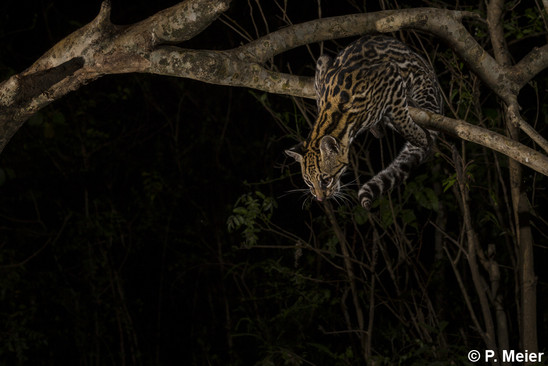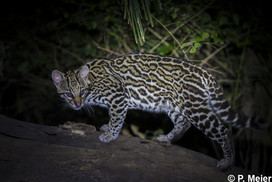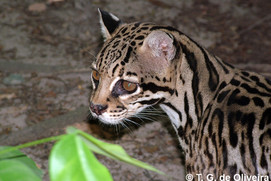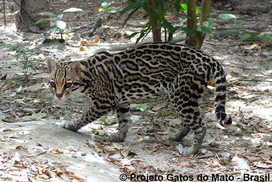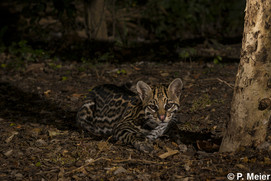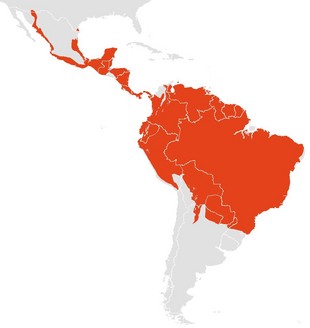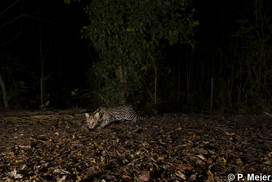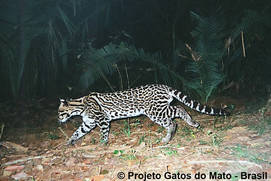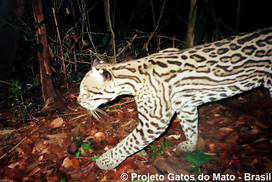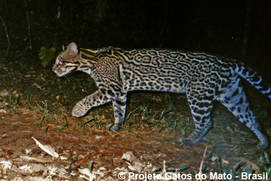Ocelot
Leopardus pardalis
IUCN Red List: Least Concern
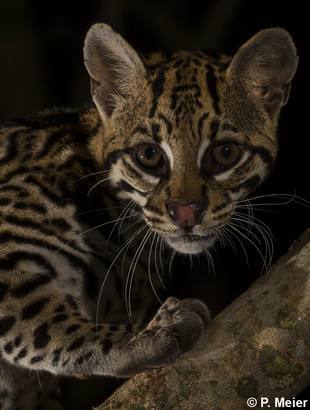
| Weight: | 8-15.1 kg |
| Body length: | 50-101.5 cm |
| Tail length: | 30-50 cm |
| Longevity: | in the wild up to 10 years; in captivity up to 20 years |
| Litter size: | 1-4 cubs |
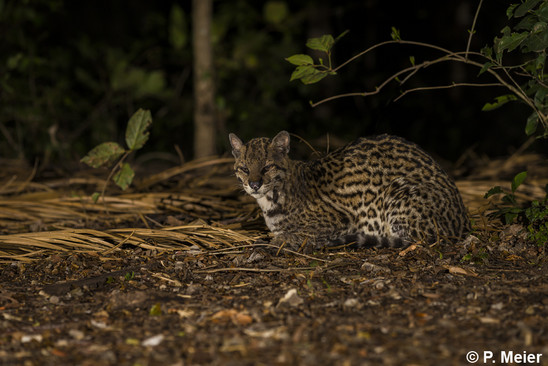
Description
The ocelot (Leopardus pardalis) is genetically very diverse across its range. Four to nine subspecies were proposed but based on recent studies, provisionally only two subspecies are recognised:
- Leopardus pardalis pardalis from Texas and Arizona south to Costa Rica and
- Leopardus pardalis mitis in South America as far south as northern Argentina (limit of range with respect to L. p. pardalis is unclear).
More detailed morphological and molecular analyses are needed to clarify the taxonomy of the ocelot. Furthermore, there have been some reports of the margay (Leopardus wiedii) hybridising with ocelots, as well as the northern tiger cat (Leopardus tigrinus) possibly hybridising with ocelots in Colombia, Venezuela, Ecuador, Bolivia and Argentina. The overall impact of this on ocelot populations however, is not reported.
The ocelot is a mid-sized cat, with a short coat varying in dorsal base colour from pale yellow, yellowish-beige, yellowish-brown to greyish. It is covered with dark black spots, stripes and rosettes which get smaller on the limbs and coalesce to form the typical longitudinal bands on the sides. The throat and belly are white and it has rounded ears with black backsides and central white dots. The ocelot’s tail is typically short with black rings or bars on the top side. Each individual is visually unique, and pelage colours may vary between and within populations. In 2004 in the Chaco of western Paraguay, a white ocelot with black markings was pictured. This is the first known record of an animal with such a coat pattern, even though there have been two unconfirmed similar reports from Brazil from the 1980s.
The ocelot has relatively stout legs and large but proportional paws, with the front slightly larger than the hind paws. Males typically weigh more than females, and rainforest ocelots tend to be bigger than those of semi-arid habitats.
Language/Country | Name |
|---|---|
Argentina | tirica, gato onza, chivi-guazu, cuanguaro |
Bolivia | gato onza, tigrezillo, gato bueno |
Brazil | maracajá-açu, jaguatirica, gato-maracajá, maracajá-verdadeiro |
Colombia | maracaya, maracaja |
Costa Rica | manigordo |
French | ocelot |
French Guiana | chat tigre |
German | Ozelot |
Guarani | agua-tirica |
Mayan | zac-xicin |
Nicaragua | mandigordo |
Panama | mandigoldo, gato tigre, tigre chico |
Paraguay | chivi-guazu, gato onza |
Peru | gato onza, pupillo, tigrillo |
Spanish | tigrillo, ocelote, gato onza |
Surinam | hétigrikati |
Venezuela | cuanguaro, manigordo |
Status and Distribution
The ocelot is classified as Least Concern in the IUCN Red List. The number of ocelots is not known exactly but presumed to be declining across its range. In Brazil the ocelot is classified as Least Concern, despite being classified as Critically Endangered in the state of Minas Gerais, and Vulnerable in Espirito Santo, Rio de Janeiro, Sao Paulo, Parana and Rio Grande do Sul. The populations in Colombia and Argentina are considered Vulnerable. In Mexico and in the United States, the ocelot is listed as Endangered. In the United States, in Texas, the ocelot declined dramatically, with numbers estimated at a mere 50-80 individuals. In comparison, the biggest population is thought to live in Brazil, where numbers are thought to reach over 40,000 individuals. In areas of the Amazon basin, ocelot populations seem to be stable. In Argentina, the ocelot population is estimated at 1,500-8,000 animals.
The ocelot is a mid-sized felid, reaching one of the highest densities and distributions of all tropical species of Neotropical cats, with an average of 31.1 individuals per 100 km². Ocelot densities can vary from 0.63–174 individuals/100 km². The highest recorded density was detected at the Barro Colorado Island in Panama. The lowest densities were detected in Sonora, Mexico as well as in the tropical deciduous forests in Mexico, in the Bojonawi Reserve in Colombia, in the pine forest of Belize, and in the Brazilian Caatinga. It has been suggested that ocelot densities are correlated with precipitation and latitude, which is an indicator of productivity. However, observed densities do not always conform to this assumption.
Country/Region | Density /100 km² |
|---|---|
Argentina, Atlantic forest | 12.9-19.1 |
Belize, pine forest | 3.1 |
Belize, broadleaf rainforest | 25.8 |
Bolivia, eastern part | 24-66 |
Brazil, south-eastern Pantanal region | 62 |
Brazil, northern Pantanal region | 11.2 |
Brazil, Central Amazon | 24.84 - 6.27 |
Brazil, Atlantic forest | 4-62 |
Brazil, Caatinga | 3.16 ± 0.46 |
Colombia | 11 |
Colombia (Bojonawi Reserve) | 1.8 ± 1.5 |
Costa Rica | 6.5 |
Ecuador, Amazon | 32-52 (rain season), 41-47 (dry season) |
Guatemala | 13 ± 1.4 |
Mexico, tropical deciduous forest | 2.9 |
Mexico, Sonora | 1.58 ± 0.08 |
Panama, Barro Colorado Island | 174 |
Panama | 62.7 |
Peru, Amazon | 94.7 |
Peru, south-eastern part | 80 |
Texas, thorn scrub forest | 30 |
The distribution range of the ocelot is large. Previously it occurred as far north as Arkansas and Arizona in the United States. Although in 2010, an ocelot was again recorded in Arizona, where it occurred historically, it is now most likely restricted to Texas. Currently, its distribution spans from Texas in the US over the coast of Mexico throughout Central and South America, south to north-eastern Argentina, southern Brazil, and exceptionally into north-western Uruguay. It does not occur in Chile.
Habitat
Throughout its vast range, the ocelot occupies a large variety of different habitats, but tends to be most commonly associated with closed, dense habitats such as evergreen forest and areas near fresh water.
Ocelot habitats may also include tropical and subtropical dry, floodplain, deciduous, semi-deciduous, coastal, lowland, montane, pre-montane, riparian or coniferous forests, but they significantly avoid Bamboo forest. They also occur in dry thorn scrub of the semiarid chaparral, Caatinga and Chaco, mangroves, coastal vegetation and seasonally flooded savannah, both pristine and disturbed. The ocelot is very adaptable even to disturbance, and occasionally uses open areas including croplands if preferred habitat features are available (sufficient amount of cover or a high prey density), but typically only on cloudy days or moonless nights. Furthermore, ocelots were also recorded in mosaic habitats where the native vegetation has been partially replaced by pine plantations, oil palm plantations, wetland palm plantations, or agricultural fields. Moreover, ocelots are sensitive to human presence and activity as well as the occurrence of domestic dogs, and rarely occur abundantly in areas where these factors are high. One study in the Caribbean region of Colombia however, did observe a radio-collared female ocelot using disturbed habitats more than was previously recorded. There are also reports of ocelots using eucalyptus forests bordering reserves as travel routes between native areas. Ocelots have been recorded walking on man-made trails and roads for extensive periods of time. In southern Brazil, ocelots were found to be positively associated with roads and areas with a high biomass of prey, regardless of vegetation structure. The ocelot typically occurs at elevations below 1,200 m but has also occasionally been recorded at higher elevations up to 3,800 m.
Ecology and Behaviour
The distribution range of the ocelot in South America overlaps with that of most other Neotropical small cat species. As a generalist carnivore and as the largest and most adaptable of the small cat species in tropical America, it dominates these other species. In areas where the ocelot occurs, species like the tiger cats (L. tigrinus/L. guttulus), margay (L. wiedii), jaguarundi (Herpailurus yagouaroundi), and Geoffroy‘s cat (L. geoffroyi), avoid the ocelot. This negative effect on other smaller sympatric species is called the “ocelot effect”. Many studies challenge this phenomena however, and argue that the distribution of small and medium felids is more strongly influenced by prey availability and landscape attributes such as forest type than intraguild competition. Nonetheless, the same pattern was also found with free-ranging domestic dogs.
The ocelot is a solitary animal. Although it can be active during both day and night, it is typically most active at night or crepuscular, and rests during daytime in trees, bushes, thickets, or ground depressions. It has nocturnal activity peaks which may be associated with the activity of its prey. The ocelot is well adapted for hunting at night, with both highly developed night vision and a keen sense of smell. It has also been suggested that the ocelot’s nocturnal behaviour is an avoidance mechanism, allowing it to coexist with the cathemeral puma, and the diurnal humans. In fact, research indicates that ocelots alter their temporal and spatial activity to explicitly avoid humans and any species (wild or domestic) that may indicate human presence. Studies in the Brazilian Atlantic Forest indicated ocelot abundance to be positively correlated with both reserve size and the presence of top predators jaguar and puma, whose presence may be indicative of lower anthropogenic influence on the landscape. Research from the Brazilian Caatinga suggests that ocelots are more predominantly nocturnal in areas with harsh conditions such as extreme heat by day compared to less harsh environments where daytime activity is more common.
The ocelot is a good swimmer and excellent climber, escaping into trees when it is threatened. Ocelots use communal latrines and scent marking by spraying urine, as a message board between conspecifics. It has been suggested that both males and females use communal latrines and scent markings to advertise breeding condition or to assess the area for suitable mates. Ocelots have also been observed investigating scent markings of other species, most likely to detect the presence of larger conspecifics such as puma or jaguar.
The mean daily travel distances range from 1.8 to 7.6 km. Males travel up to twice as far as females. A recent study suggested that ocelot hunting efficiency improves in full moon, due to switching their target prey species according to the moon phases. The ocelot generally hunts on the ground, but is known to take down arboreal species like monkeys and sloths. Its hunting behaviour varies, taking advantage of seasonal changes in prey abundance, however seasonality does not seem to significantly affect its nocturnal activity behaviour in the Brazilian Pantanal.
Home ranges of males are bigger than the ones of females and encompass around 2–3 female home ranges. Reported home range sizes may vary from 0.8 to 90.5 km². The smallest home ranges were found in the Bolivian Chaco, Brazilian Pantanal, Peruvian Amazonia, Panama and in Texas, while the largest were in the subtropical forests of Argentina and Brazil. In all the study sites, mean home ranges of adult males were significantly larger than those of adult females. Furthermore, intrasexual overlap in home ranges is common, because it is costly for individuals to maintain individual territories when density is high.
Country/Region | Home range size km2 |
|---|---|
Argentina, Urugua-í, Iguaçu National Park | 4.18-11 (females), 3.19-37 (males) |
Belize | 14.3 (average of 2 females) |
Brazil, Iguaçu National Park | 11.3 |
Brazil, Pantanal | 8 |
Peru, Manu National Park | 1.6 and 22.5 (2 females), 5.8 and 8.1 (2 males) |
USA, Texas | 12.3 (average of 5 males), 3.4. (average of females) |
Venezuela, Llanos | 9.3 and 11.1 (2 males) |
The reproductive season of the ocelots is probably year-round with peaks in different months depending on the area. The first reproduction in females takes place at around 18–22 months but is probably related to territory acquisition. Oestrus lasts for 4.6 ± 0.6 days, and the mean interoestrous interval is 17.3 (6 – 51) days. The gestation period is 66-83 (mean = 72.2) days. The inter birth interval is thought to be two years and the age of independence is also probably approximately the same. Newborn cubs weigh around 200 g. They open their eyes at 15–18 days, walk at about 3 weeks and leave the den to hunt at 4 to 6 weeks. The cubs' eyes are blue and turn to brown in the first months. At the age of about 1.5–2 years the young disperse. A study in Belize estimated annual survival rates for ocelots at 71-79%, with no variation between years or study sites.
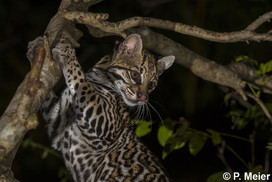
- Ocelot in the Pantanal, Brazil
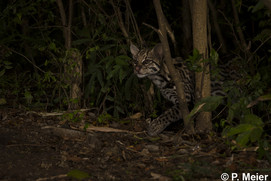
- Ocelot looking for food, Pantanal, Brazil.
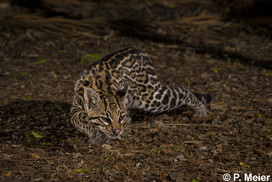
- Ocelot smelling food, Pantanal, Brazil.
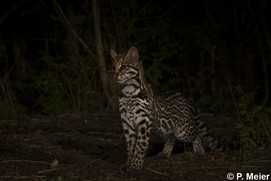
- Ocelot in the Pantanal, Brazil.
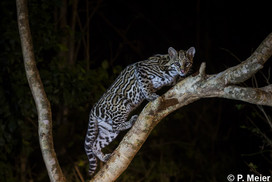
- Ocelots are good climbers.
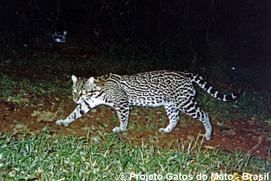
- Ocelots are most active at night
Prey
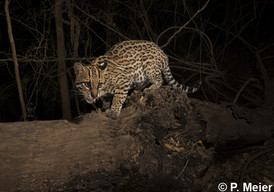
With craniodental adaptations and a larger body size to feed on both small and large prey, the ocelot is considered an opportunistic carnivore. Their prey varies from mostly small (roughly 90% of prey weighs < 1kg) to medium (1–15 kg) and occasionally also large sized prey (> 15 kg). The ocelot is the only felid of the small-medium sized Neotropical cat guild that consistently takes prey weighing more than 1 kg.
Average mean mass of mammalian prey is high (1.5 kg), due to the importance of larger sized prey, but is also highly variable, ranging from only 0.3 kg in the Llanos floodplains of Venezuela to 3.3 kg in the Atlantic rainforest of south-eastern Brazil. Predation on rather large sized prey is not related to competitive release from jaguars, as once thought. The largest mean mass of mammalian prey taken by ocelots was from areas with substantial jaguar populations. Previously, the ocelot was thought to rely mostly on small animals (typically weighing below 0.6 kg), such as reptiles, birds, frogs, crabs, beetles, small rodents, marsupials like cane mice, marsh, spiny and rice rats as well as opossums. However, it has recently been shown that ocelots could be dependent on larger prey (> 1 kg), like agoutis, pacas, armadillos, anteaters, monkeys, snakes, sloths, Brazilian rabbits, porcupines and even deer. These larger sized prey have a significant contribution in terms of biomass consumed, even though small mammals are numerically the prominent prey. Reptiles such as snakes, lizards, iguanas, tegus, tortoises and occasionally even young alligators are also taken. Additionally, there have been reports of ocelots preying on newborn giant otter cubs. In the seasonally flooded forests, ocelots take advantage of seasonally available resources like fish and crabs. There have also been some records of ocelots occasionally catching bats, indicating not only another possible prey species, but also another possible hunting method of jumping and catching its prey.
There have also been reports of ocelots along with jaguars and pumas consuming wild rice and other plant matter, which may help with the digestion of bones and other coarse material. Due to the ocelot having such a wide array of prey species, they are important predators in most ecosystems, helping to control the population density of prey species.
Research indicates that ocelots may indirectly contribute to the recruitment of plants throughout the forest. This occurs because a large portion of the preferred prey of ocelots are seed collectors, who collect and bury seeds, to be consumed later when resources are scarce. If the animal is however preyed on by the ocelot, the seed remains in the soil and is able to germinate.
Ocelots in south-eastern Brazil were observed to have a high temporal overlap with their prey species, compared to the smaller felids such as jaguarundi, Northern tiger cat, Southern tiger cat and margay.
Main Threats
The ocelot has generally been considered to be tolerant to disturbed habitat. Recent studies however depict a more specialized animal operating under rather harsh environmental constraints, which is only able to adjust to these transformed areas if there is suitable habitat in adjacent areas.
The main threats for the ocelot are habitat destruction and fragmentation (mainly due to logging and agricultural activities) leading to a loss of prey base and cover, both of which the ocelot is highly sensitive to. Additionally, ocelots face the risk of population isolation due to habitat fragmentation, which may lead to a loss of genetic diversity. Due to their long gestation period, small average litter size and slow growth rate, ocelots are adapted to low rates of energy acquisition, making them and their offspring often susceptible to starvation. As a result, ocelot populations often struggle to recover from a loss, and are therefore highly susceptible to these threats.
Genetic analysis in the US showed that the two Texan populations were genetically significantly different from each other as well as from the ones in north-eastern Mexico. The extensive agricultural and urban development seems to act as a barrier, isolating these populations. It has been suggested that due to environmental stochasticity and a reduction in genetic variability, the ocelot populations in Texas may face a high risk of extinction in less than 40 years. The only aspect of habitat fragmentation that may benefit ocelots to some extent, is the strong negative effect it has on larger carnivores, giving rise to some elements of mesopredator release.
In Texas, as well as Brazil, many ocelots are killed by traffic. A 2018 study in Mexico also reported road killed ocelots in 10 of 25 states where it lives (40%). Not only does road traffic threaten ocelot populations by direct mortality, but roads may also act as a barrier between populations. This leads to potentially reduced breeding opportunities, the forced use of poor quality habitat which may lead to decreased fitness and thus a significantly reduced population survival probability.
Although widespread commercial harvests for the fur trade ceased decades ago, illegal fur and souvenir trades still persist and ocelots are also used in the pet trade. Moreover, retaliatory killing due to depredation of poultry often takes place. Although indigenous people generally do not hunt ocelots for food, they may occasionally compete for the same prey species, and therefore the ocelot suffers under competitive pressure from humans in some areas. Although the hunting of ocelots is regulated in Peru, there are no legal protective measures in place in in Ecuador, El Salvador, and Guyana. It is possible that despite protective measures being in place inside some protective areas, the hunting outside of protected areas can have dramatic flow-on effects to the viability of local ocelot populations inside protected areas.
Additionally, various populations of free ranging domestic carnivores (cats and dogs) in the ocelot’s area of occurrence have been found to carry a variety of diseases and parasites, potentially affecting ocelots and other wild felids. The actual rate of transmission and the effect of diseases and parasites on the ocelot populations remains understudied. Ocelot numbers have been shown to negatively correlate with presence of free ranging domestic dogs in an area, indicating that they also pose other threats to ocelots than disease transmission.
Conservation Efforts and Protection Status
The ocelot population was declining heavily due to the extensive fur trade, which lasted from the early 1960’s to the 80’s. In this time period more than 566,000 ocelot pelts were officially commercialised. After the implementation of new protection measures in many countries of its distribution, and by putting import bans on all spotted cat species, the trade slowed down. In 1989, the ocelot was included in the Appendix I of CITES and is today protected in most countries of its distribution range. Hunting is prohibited in Argentina, Belize, Brazil, Bolivia, Colombia, Costa Rica, French Guiana, Guatemala, Honduras, Mexico, Nicaragua, Panama, Paraguay, Suriname, Trinidad and Tobago, the United States, Uruguay, and Venezuela and regulated in Peru. Only in Ecuador, El Salvador and Guyana, is the ocelot not legally protected. In many regions, the ocelot was able to recover from overexploitation in the past, and in November 2009 an individual was observed as far north as Arizona, where it historically roamed. The protective measures taken at regional and national scales, and the implementation of international trade restrictions were based on scientific research on the status of the ocelot and on monitoring information.
In the U.S. today, the ocelot is a conservation priority. The suspected isolated populations in Mexico can probably only be connected by translocations. Another important measure would be to build up corridors to assure gene flow between the different populations. In Brazil, ocelot populations are well protected within the reserves throughout the country, especially those in Amazonia, where the species is fairly common.
Protection, maintenance and restoration of forest fragments and wetlands across agricultural landscapes is essential to maintain suitable habitat for the ocelot and connectivity between populations. If connectivity is increasingly reduced, the ocelots face the risk of population isolation and in turn a loss in genetic diversity, as has already been observed in the Atlantic Forest Morro do Diabo in southern Brazil. Moreover, buffer zones are also essential areas for many species including the ocelot, and are often overlooked in terms of conservation importance. Additionally, it is important that any new oil palm plantations or other agricultural expansion is developed on already-existing pasture land, and with the aid of subsidies or other rewards systems, encourage the preservation of natural areas within productive landscapes. This is not only because pasture areas negatively affect the occurrence of the ocelot as well as other species, but this method also limits further destruction of important natural habitats such as forests and wetlands. The current IUCN conservation status of the ocelot is “Least Concern” due to assumed high abundance and genetic diversity. However if habitat fragmentation continues, genetic diversity will be lost, and therefore a regular review of the conservation status is necessary.
In an attempt to reduce human-wildlife-conflict between ranchers and local carnivores in Sonora Mexico, camera traps were set up on private ranch land. Ranchers were rewarded in cash payments for photographs of jaguar, puma, ocelot or bobcats. With this economic incentive, ranchers were more likely to tolerate these species on private land.
In Texas, measures to mitigate ocelots killed by traffic are now in place, but wildlife road crossing structures as well as speed reducers and highway fencing should be implemented throughout the entire Neotropical expanse.
The control of domestic dogs and poaching activity is also vital for the biodiversity in the Neotropics, and ultimately for ocelot populations.
